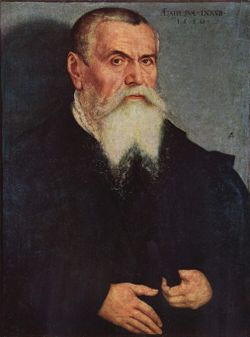(Kronach, 1472 - Weimar, 1553)
Lucas Cranach the Elder (known in German as Lucas Cranach der Ältere) was a German Renaissance painter and graphic artist famous for his female nudes and portraits. Cranach, whose real name may have been Lucas Müller or Sunder, was born on October 4, 1472, in Kranach, the city from which he took his surname. His son is also the painter Lucas Cranach the Younger.
Cranach learned to paint with his father. From 1501 to 1504, he lived in Vienna, where he created his first paintings, including a portrait of the humanist Doctor Reuss (Germanisches Museum, Nuremberg) and a Crucifixion (1503, Alte Pinakothek, Munich). During this time, his work was influenced by Albrecht Dürer.
In 1505, Cranach became the court painter of Saxony in Wittenberg, a position he held until 1550. An influential citizen in Wittenberg, he received a title and became mayor in 1537.
In 1508, he visited Holland, where he painted royalty: Emperor Maximilian I and Charles I. He also painted biblical and mythological scenes filled with decorative nudes, a novelty in German painting. Among his works are many versions of Adam and Eve, The Judgment of Paris (1529, Metropolitan Museum of Art, New York), and Venus and Cupid (1531, Musées Royaux des Beaux-Arts, Brussels).
A friend of Martin Luther, Cranach's art expressed the spirit and sentiments of the German Reformation. Many of his portraits and engravings served as propaganda for the Protestant cause. His portraits of Protestant leaders, including many versions of Luther and Duke Henry of Saxony (1514, Dresden Portrait Gallery), are sober and meticulously designed.
Cranach and his team worked with great speed, producing nearly 5,000 graphic artworks, of which only 1,000 survive today.
He died on October 15, 1553, in Weimar.
Lucas Cranach the Elder (known in German as Lucas Cranach der Ältere) was a German Renaissance painter and graphic artist famous for his female nudes and portraits. Cranach, whose real name may have been Lucas Müller or Sunder, was born on October 4, 1472, in Kranach, the city from which he took his surname. His son is also the painter Lucas Cranach the Younger.
Cranach learned to paint with his father. From 1501 to 1504, he lived in Vienna, where he created his first paintings, including a portrait of the humanist Doctor Reuss (Germanisches Museum, Nuremberg) and a Crucifixion (1503, Alte Pinakothek, Munich). During this time, his work was influenced by Albrecht Dürer.
In 1505, Cranach became the court painter of Saxony in Wittenberg, a position he held until 1550. An influential citizen in Wittenberg, he received a title and became mayor in 1537.
In 1508, he visited Holland, where he painted royalty: Emperor Maximilian I and Charles I. He also painted biblical and mythological scenes filled with decorative nudes, a novelty in German painting. Among his works are many versions of Adam and Eve, The Judgment of Paris (1529, Metropolitan Museum of Art, New York), and Venus and Cupid (1531, Musées Royaux des Beaux-Arts, Brussels).
A friend of Martin Luther, Cranach's art expressed the spirit and sentiments of the German Reformation. Many of his portraits and engravings served as propaganda for the Protestant cause. His portraits of Protestant leaders, including many versions of Luther and Duke Henry of Saxony (1514, Dresden Portrait Gallery), are sober and meticulously designed.
Cranach and his team worked with great speed, producing nearly 5,000 graphic artworks, of which only 1,000 survive today.
He died on October 15, 1553, in Weimar.


